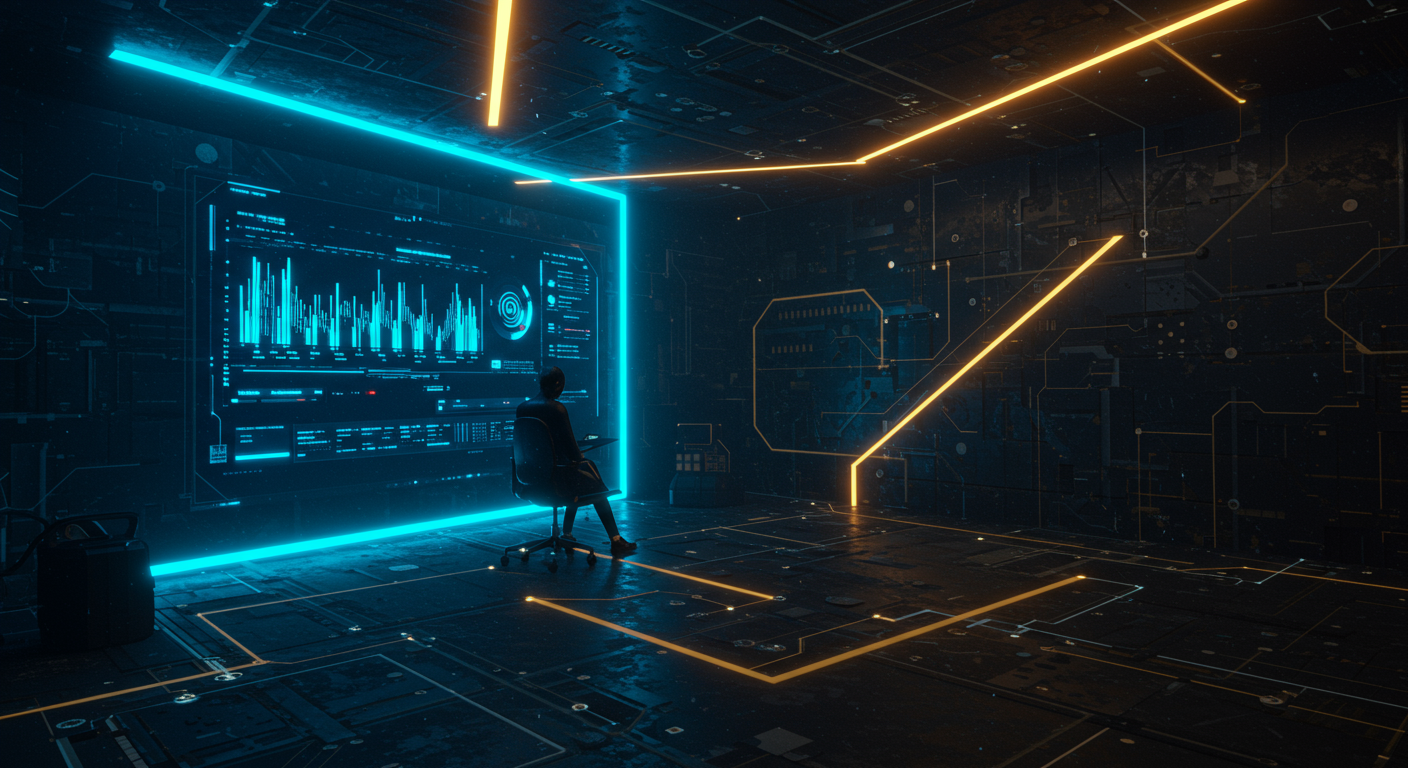AI Judge Bias: Unveiling the Human Element in Algorithmic Assessment

Here's how technically advanced algorithms can reflect human biases.
The AI Judge Paradox: Technical Prowess vs. Human Perception
AI judges are increasingly used for decision-making, promising objectivity across sectors from healthcare to law. But are they truly neutral?
Databricks research suggests that AI judge performance is significantly impacted by human factors, revealing a critical paradox.
Unveiling the Paradox
The "AI Judge Paradox" highlights a troubling reality:
- Sophisticated Algorithms, Biased Outcomes: Technically advanced algorithms can still reflect and amplify human biases.
- Human Influence: > It's not just about the algorithm itself, but the data it's trained on and the humans who design and deploy it. Think of it like a mirror – AI can only reflect the data it’s fed, and if that data is skewed, so is the reflection.
- Challenges of AI judges: We need to consider human bias in AI decision making before widespread adoption.
Addressing the Core Issue
The key to fairer AI judges isn't just writing better code. Here's what really matters:
- Mitigating Human Bias: Understand and mitigate biases in the development and deployment processes.
- Focus on Data: Clean, representative data is paramount.
- Transparency & Accountability: Build explainable AI (XAI) and establish clear lines of responsibility. You can learn more about this in our AI Glossary.
Decoding Databricks' Research: Key Findings and Implications
Databricks' research offers a crucial glimpse into how human biases infiltrate AI judge systems, highlighting a challenge we must address head-on. Let's unpack the key findings.
Research Methodology and Bias Identification
Databricks' study employed a multi-faceted approach to uncover hidden biases. They analyzed AI judge performance across diverse datasets, comparing results against human benchmarks. The methodologies included:
- Comparative Analysis: AI outputs were rigorously compared to human-generated content across various demographic categories.
- Bias Detection Metrics: Specific metrics were used to identify patterns of disparity in accuracy and fairness.
- Qualitative Review: Human experts assessed AI-generated content for subtle indications of bias.
Implications on Accuracy and Fairness
The presence of human bias significantly compromises the accuracy and fairness of AI judges. This leads to:
- Reduced Reliability: AI systems may produce skewed assessments, undermining trust in their decisions.
- Disproportionate Impact: Some demographic groups might experience unfairly negative evaluations. For example, cultural nuances in language used by certain demographics may be misinterpreted.
Disproportionate Effects on Demographic Groups

Certain demographic groups might face a greater risk of misjudgment due to existing societal biases. This includes:
- Linguistic Bias: Accents or dialects less represented in training data could lead to inaccurate evaluations.
- Cultural Bias: AI judges may misinterpret cultural references or contextual nuances, leading to unfair assessments.
In conclusion, Databricks' AI bias research underscores the urgent need for strategies to mitigate human biases in AI development. Further exploration into ethical AI practices is vital to ensure that AI systems provide fair and accurate assessments for all.
It's increasingly clear that AI judges, while seemingly objective, can inherit and amplify the biases of their creators and the data they're trained on.
The Data's Story: Collection and Labeling

AI judges are only as good as the data they learn from. This is where the first layer of human bias emerges.
- Data Collection: If the data used to train an AI judge disproportionately represents one demographic over another, the AI will likely reflect this imbalance. For example, if a facial recognition system used in law enforcement is primarily trained on images of one race, it's more likely to misidentify individuals of other races.
- Data Labeling: Humans label data, and those labels are not free from unconscious bias. Consider an AI used to assess loan applications; if loan officers have historically undervalued applications from minority groups, the AI trained on their decisions will likely perpetuate this bias. AI Data Labeling shows how humans add bias to ML models.
Algorithmic Architecture and Metric Selection
Bias doesn't just creep in through data; it can also be baked into the algorithm itself.- Algorithm Design: The choice of algorithm and its parameters can inadvertently favor certain outcomes. A poorly designed risk assessment algorithm, for instance, might overemphasize factors correlated with race or socioeconomic status, leading to unfair predictions.
- Evaluation Metrics: How do we measure an AI judge's success? If the evaluation metrics are skewed, they can mask underlying biases. If an AI judge appears accurate overall but consistently fails for a specific group, the metrics aren't telling the whole story.
Cognitive Biases in AI Development
Even with the best intentions, developers can introduce bias through cognitive biases in AI development. Confirmation bias, for example, might lead developers to selectively focus on data that confirms their pre-existing beliefs about fairness. Moreover, unconscious biases can influence design decisions in subtle yet significant ways. Consider:- Anchoring bias
- Availability heuristic
Here's how we can ensure AI judges are dispensing justice, not just code.
Beyond the Algorithm: Strategies for Mitigating Bias in AI Judges
AI judges, while promising impartiality, are susceptible to biases woven into their data and algorithms. Implementing effective bias mitigation techniques is crucial for fairness.
Building a Diverse Team
"Diversity isn't just a feel-good concept; it's a critical ingredient for building responsible AI."
- Diverse teams in AI development and testing can catch biases that homogeneous groups might miss.
- Including people from varied backgrounds (race, gender, socioeconomic status) brings different perspectives to the table.
- Example: A team designing an AI for loan applications should include members familiar with the challenges faced by diverse communities.
Bias Detection and Correction
- Focus on bias mitigation techniques in AI:
- Data audits: Scrutinize datasets for skewed representation.
- Algorithmic fairness metrics: Use tools that highlight disparate impact.
- Regularization techniques: Modify algorithms to penalize bias.
- Consider using fairness-aware AI development tools that provide bias detection and correction capabilities. They can help identify and address biases in both data and algorithms.
Transparency and Explainability
- Implement techniques promoting explainability in AI decision-making:
- Explainable AI (XAI): Use models that reveal their decision-making processes.
- Transparency reports: Document how the AI works, its limitations, and potential biases.
- Think of it like a transparent courtroom—everyone deserves to understand how the verdict was reached.
Fairness-Aware AI Development
- Embrace 'fairness-aware' AI development:
- Incorporate fairness metrics directly into the AI’s objective function.
- Continuously monitor and refine the AI to maintain fairness over time.
- This proactive approach ensures fairness remains a core value, not an afterthought.
Building Ethical AI Ecosystems: A Collaborative Approach
The true potential of AI to judge fairly hinges on our collective responsibility to build ethical systems from the ground up.
The Power of Partnership
It's not enough to leave ethical considerations to the coders alone; collaboration is key.- Researchers: Identifying potential biases.
- Developers: Implementing safeguards and testing rigorously.
- Policymakers: Crafting regulations to ensure fairness.
- The Public: Participating in discussions about ethical implications.
Guiding Principles
Ethical AI frameworks are essential for guiding responsible development.- Establishing clear values and principles
- Providing practical guidelines for AI design and deployment
- Fostering transparency and accountability
Audits and Accountability
AI audit and certification standards can provide assurance that systems are fair and unbiased.- Regular audits to detect and address bias
- Certification processes to verify compliance with ethical guidelines
- Promoting trust and confidence in AI systems
Continuous Vigilance
Bias can creep into AI systems over time, making constant monitoring critical.- Establishing feedback loops to identify bias
- Implementing mechanisms for continuous evaluation
- Ensuring AI remains fair and equitable long-term
The rise of AI judges demands we confront inherent biases, but emerging technologies offer a path forward for more equitable systems.
Mitigating Bias with Emerging Technologies
The future of fairness-aware AI hinges on our ability to leverage novel approaches. Emerging technologies for AI bias mitigation, such as federated learning and differential privacy, offer promising avenues:- Federated Learning: This allows AI models to be trained across multiple decentralized devices or servers, holding local data samples, without exchanging them.
- Differential Privacy: This adds statistical noise to data, obscuring individual information while preserving overall trends. This ensures the model learns from the data without revealing sensitive details that could perpetuate bias.
Ongoing Research and Development
Ongoing research and development are crucial. Fairness-aware AI is a rapidly evolving field, with academics and industry experts working tirelessly to improve algorithms and evaluation metrics. This includes:- Developing new algorithms that are inherently more resistant to bias.
- Creating more comprehensive datasets that reflect the diversity of the populations they serve.
- Establishing standardized benchmarks for evaluating the fairness of AI systems.
A Call to Ethical Action
It's our collective responsibility to prioritize ethical considerations. As individuals and organizations, we must:- Advocate for transparency in AI development and deployment.
- Invest in fairness-aware AI research.
- Demand accountability from AI developers and policymakers.
One of AI’s most pressing challenges is mitigating bias in algorithmic assessments.
Criminal Justice: COMPAS Recidivism Tool
In the criminal justice system, the Correctional Offender Management Profiling for Alternative Sanctions (COMPAS) algorithm was used to predict recidivism risk, but it disproportionately flagged Black defendants as higher risk compared to white defendants.A ProPublica analysis revealed that COMPAS was more likely to falsely flag Black defendants as future criminals, highlighting the need for fairness-aware algorithms and careful validation.
Mitigation strategies include using fairness metrics during training and regularly auditing model outputs for disparate impact.
Healthcare: Diagnostic AI
In healthcare, AI algorithms trained on predominantly white patient data can exhibit bias when applied to patients from other racial or ethnic groups. For example, a diagnostic AI might be less accurate in detecting skin cancer in individuals with darker skin tones.- Mitigation: Diverse datasets, algorithm audits, and human oversight by healthcare professionals are crucial.
- Impact: Improved diagnostic accuracy and equitable healthcare access.
Finance: Credit Scoring Algorithms
AI-powered credit scoring algorithms can perpetuate existing inequalities if trained on biased historical data. This can lead to unfair denial of credit to individuals from marginalized communities. Successful mitigation strategies involve:- Carefully selecting input features to avoid proxies for protected characteristics.
- Using fairness-aware machine learning techniques.
- Regularly monitoring for disparate outcomes.
By learning from these examples of successful AI bias mitigation, developers can build fairer and more equitable AI systems across various domains.
Keywords
AI judges, AI bias, human bias, algorithmic fairness, Databricks research, AI ethics, machine learning bias, fairness-aware AI, AI accountability, responsible AI, bias mitigation, ethical AI, AI auditing
Hashtags
#AIethics #AIBias #ResponsibleAI #AlgorithmicFairness #MachineLearning
Recommended AI tools
ChatGPT
Conversational AI
AI research, productivity, and conversation—smarter thinking, deeper insights.
Sora
Video Generation
Create stunning, realistic videos and audio from text, images, or video—remix and collaborate with Sora, OpenAI’s advanced generative video app.
Google Gemini
Conversational AI
Your everyday Google AI assistant for creativity, research, and productivity
Perplexity
Search & Discovery
Clear answers from reliable sources, powered by AI.
DeepSeek
Conversational AI
Efficient open-weight AI models for advanced reasoning and research
Freepik AI Image Generator
Image Generation
Generate on-brand AI images from text, sketches, or photos—fast, realistic, and ready for commercial use.
About the Author

Written by
Dr. William Bobos
Dr. William Bobos (known as 'Dr. Bob') is a long-time AI expert focused on practical evaluations of AI tools and frameworks. He frequently tests new releases, reads academic papers, and tracks industry news to translate breakthroughs into real-world use. At Best AI Tools, he curates clear, actionable insights for builders, researchers, and decision-makers.
More from Dr.
